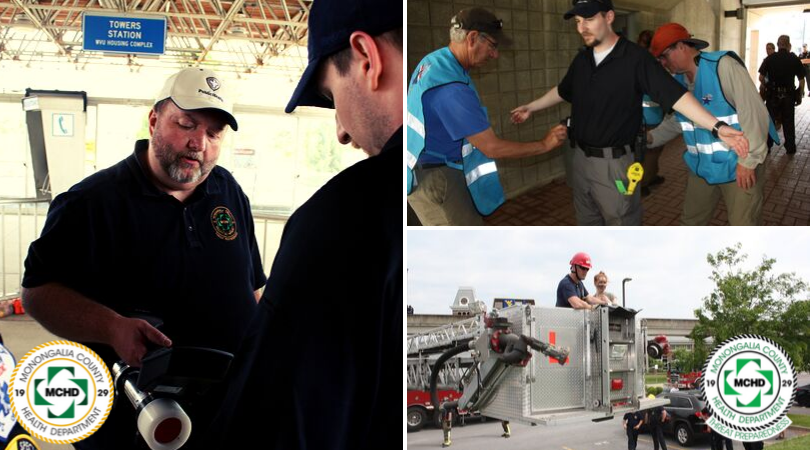In the past 18 years, Threat Preparedness has made communities safer

Sep. 11, 2019
By Mary Wade Burnside
It’s difficult to believe that it’s been 18 years since the attacks on the World Trade Center and the Pentagon that also saw a plane crash in nearby Shanksville, Pennsylvania, only a 90-minute drive away from Morgantown.
On Sept. 11, 2001, jets crashed into the Twin Towers in New York City and the Pentagon. Another plane that was believed to be headed either to the Capitol or the White House in Washington crashed after passengers launched a counterattack.
On that day, 2,996 people were killed in the attacks while more than 6,000 were injured. That included people in the Twin Towers and the Pentagon as well as airplanes passengers and first responders. Additional deaths have been attributed to the after-effects of inhaling smoke and dust.
Of course, we all hope that the United States never sees that level of terrorism again. But we also know that the world seems like an increasingly dangerous place, with active shooters and terrorist attacks taking place along with natural disasters such as flooding, wildfires, hurricanes and tornados that are growing in frequency as well as capacity.
Monongalia County Health Department’s Threat Preparedness program, as well as similar ones across the country, were created in the aftermath of the 9/11 attacks. Exactly a week after the attacks, anthrax began showing up in envelopes that had been mailed to media outlets and the offices of two U.S. Senators. Five people died and at least 18 others were initially injured, although some officials believe that number should be higher.
When the attacks occurred, an Emergency Operations Plan was consulted that said local health departments would provide the protocol detailing steps to be followed in the aftermath of an anthrax incident. This is when MCHD Threat Preparedness was created. Three years later in 2004, September was deemed by the Federal Emergency Management Agency (FEMA) to be National Preparedness Month.
In the 18 years since 9/11 and the anthrax attacks, MCHD Threat Prep has worked to prepare both the health department as well as the community for a variety of disasters and other situations. These include not only weather events and disease-carrying vectors such as mosquitoes and ticks, but also chaos that humans can create, including mass shootings and terrorism.
MCHD Threat Prep coordinator Jamie Moore and Threat Prep specialist Joe Klass participate in a lot of different trainings. For instance, earlier this year, Jamie attended “Hospital Management for Chemical, Biological, Radiological/Nuclear and Explosives,” which was held at the U.S. Army Medical Research Institute of Chemical Defense in Aberdeen, Maryland.
Later that spring, Jamie also traveled to the Vector Summit in Pittsburgh, where he learned the latest on bugs such as mosquitoes and ticks, the diseases they can carry and what we can do to prevent people from getting sick. To that end, Jamie has spent many a summer morning and late afternoon traveling around the six-county Preparedness Action Coalition Team (PACT) region of Monongalia, Preston, Marion, Harrison, Doddridge and Taylor, setting out mosquito traps and then collecting them after at least 24 hours.
The bugs are killed by freezing them so they can be sent away and tested for diseases. This way, we will know if an area has any West Nile virus, which was found in the area last year. As fall approaches, Jamie will be switching to tick surveillance.
Both Jamie and Joe also help at WVU’s University Police and other agencies at home football games, walking around the venue with radiation detectors to make sure no one has brought any dangerous materials into Milan Puskar Stadium.
Monongalia County Health Department also participates in drills such as the one conducted by University Police in late May on the PRT to test emergency response in case something were to happen on WVU’s public transport system.
Joe, who also works as an Emergency Medical Technician (EMT), also provides trainings to health department employees, first responders and community members. These range from CPR to Stop the Bleed, which teaches people who don’t have to have medical training how they can apply pressure and tourniquets to wounds in a variety of events, from car accidents to mass shootings.
It’s not fun to think about bad things happening, but being prepared allows you to know you can do as much as possible to help yourself, your family, friends, neighbors and even strangers if something happens.
FEMA has compiled a website that allows you to brush up on the different steps you can take to be more prepared. But you don’t have to go it alone. There are trainings you can take right here in your community that will expand your horizons that hopefully you will never have to use in the real world.
By Mary Wade Burnside is the public information officer at Monongalia County Health Department.